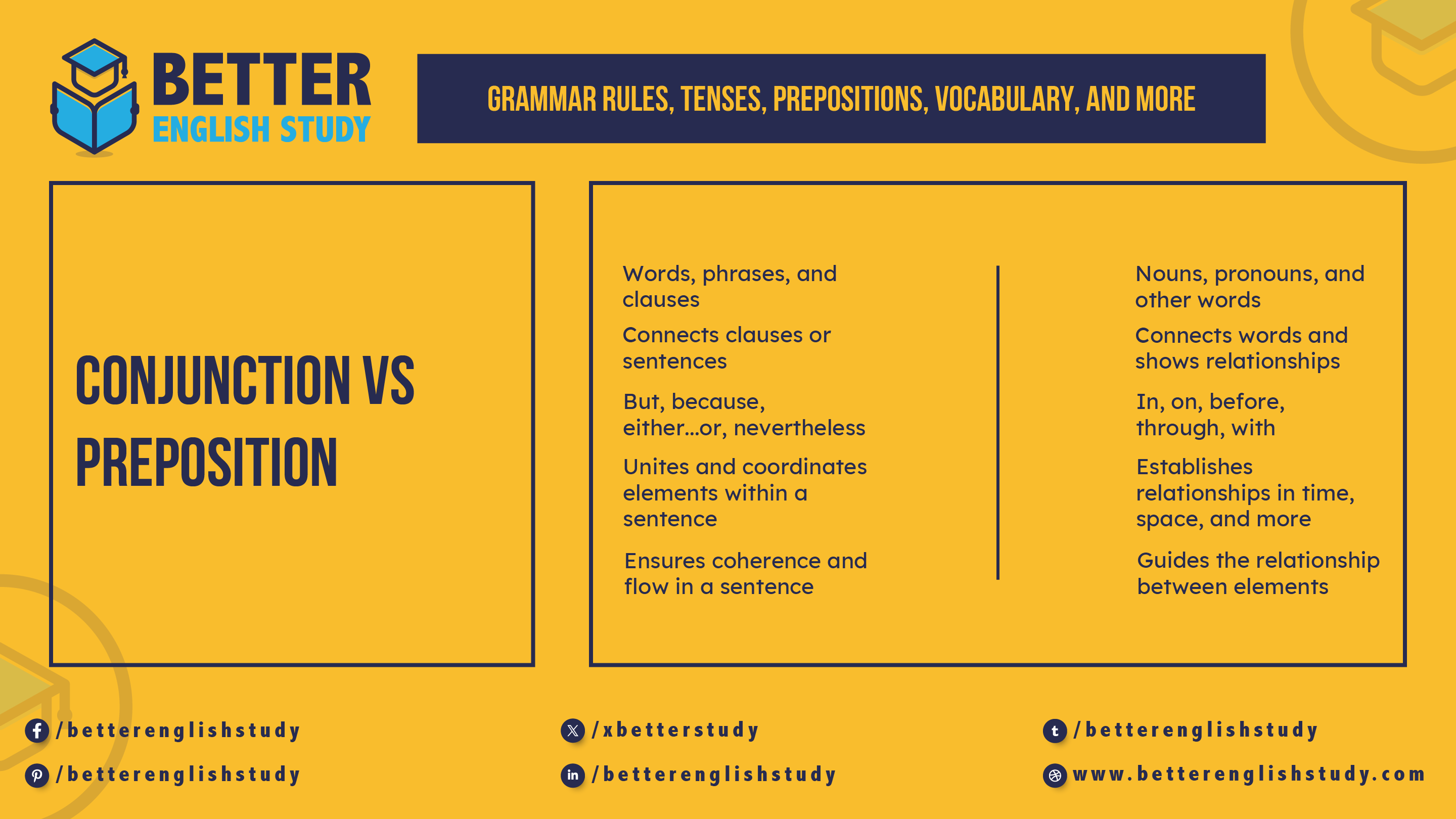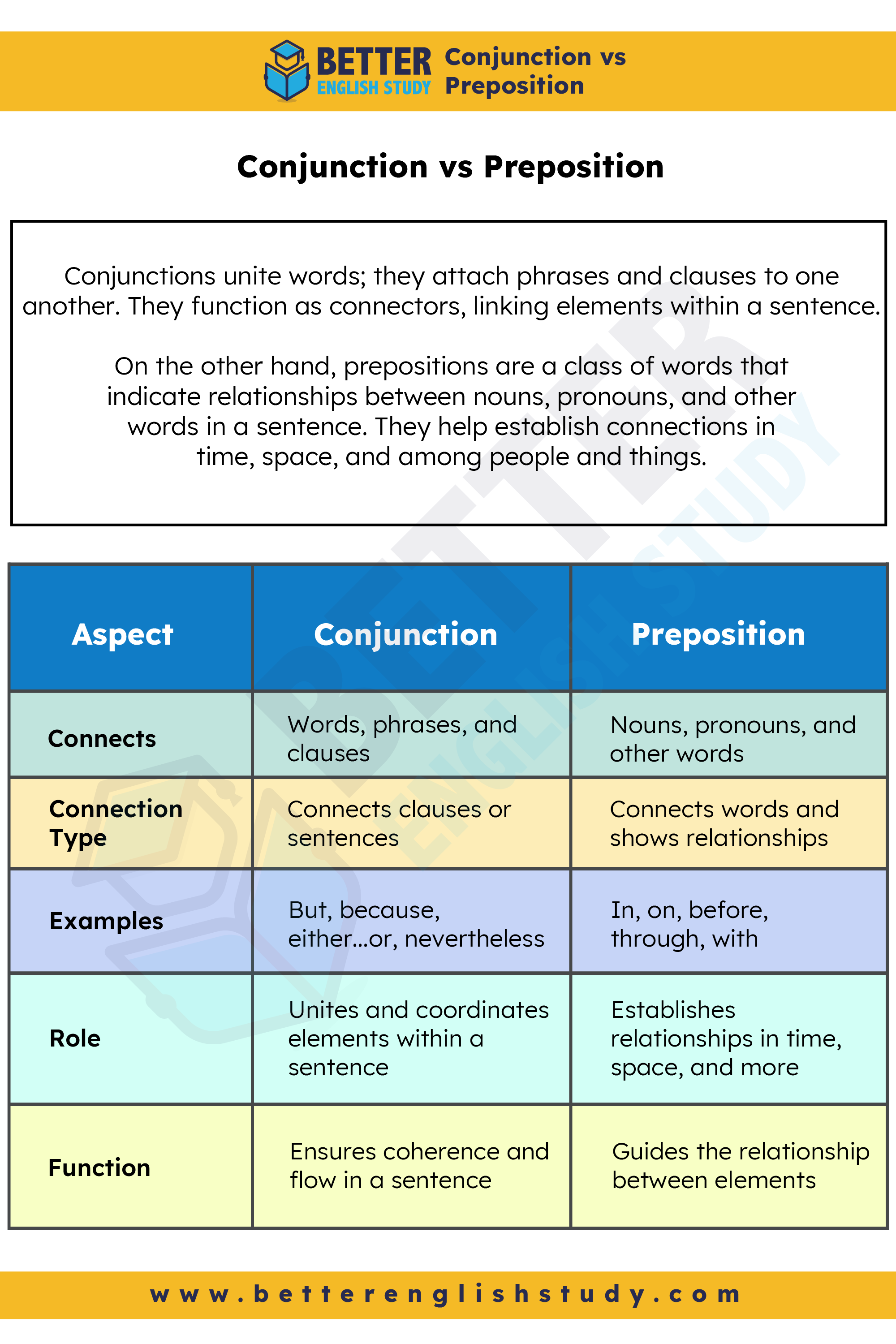
Learning a new language can be like exploring a maze, and in the labyrinth of English, understanding the difference between conjunctions and prepositions is crucial. These connecting words play a significant role in constructing meaningful sentences.
In this article, we will unravel the mysteries of conjunctions and prepositions, providing clear explanations and examples to guide you through the linguistic maze.
Conjunctions and Prepositions: What is the Main Difference?
Conjunctions unite words; they attach phrases and clauses to one another. They function as connectors, linking elements within a sentence. On the other hand, prepositions are a class of words that indicate relationships between nouns, pronouns, and other words in a sentence. They help establish connections in time, space, and among people and things.
Now, let’s break down each of these linguistic elements to gain a deeper understanding.
What is a Conjunction?
Conjunctions are the glue that holds sentences together, ensuring smooth and coherent communication. They connect words, phrases, and clauses, contributing to the overall flow of a sentence. Here are five examples:
1. Coordinating Conjunctions: FANBOYS (for, and, nor, but, or, yet, so)
- Example: She wanted to go to the party, but she had too much work to do.
- Explanation: The conjunction “but” connects two independent clauses, indicating a contrast between her desire to attend the party and the practical constraint of pending work.
2. Subordinating Conjunctions: (although, because, if, since, when, while)
- Example: He couldn’t attend the meeting because he was feeling unwell.
- Explanation: The conjunction “because” introduces a dependent clause, explaining the reason for his absence.
3. Correlative Conjunctions: (either…or, neither…nor, both…and, not only…but also)
- Example: She is not only intelligent but also hardworking.
- Explanation: The correlative conjunction “not only…but also” emphasizes the presence of both qualities in the subject.
4. Conjunctive Adverbs: (however, therefore, nevertheless, consequently)
- Example: The weather was bad; nevertheless, we decided to go for a hike.
- Explanation: The conjunctive adverb “nevertheless” connects two independent clauses, signaling a contrast.
5. Subordinating Conjunctions of Time: (after, before, when, while)
- Example: She left the house after she finished her homework.
- Explanation: The subordinating conjunction “after” introduces a time-related dependent clause.
What is a Preposition?
Prepositions serve as navigational tools, guiding us through the relationships between various elements in a sentence. They allow us to talk about the connection between two words. Here are five examples:
1. Spatial Relationship Preposition: (in, on, under, between, beside)
- Example: The cat is on the table.
- Explanation: The preposition “on” indicates the spatial relationship between the cat and the table.
2. Temporal Relationship Preposition: (before, after, during, since, until)
- Example: They will meet after the presentation.
- Explanation: The preposition “after” establishes the temporal relationship between the meeting and the presentation.
3. Possession Preposition: (of, for)
- Example: The key to success is a combination of hard work and determination.
- Explanation: The preposition “of” denotes the possession relationship between success and hard work.
4. Direction Preposition: (to, towards, through, across)
- Example: He walked to the store.
- Explanation: The preposition “to” indicates the direction of the walk, connecting the subject with the destination.
5. Prepositions with Nouns: (with, by, about)
- Example: She is passionate about literature.
- Explanation: The preposition “about” establishes the connection between the subject and her passion.
Conjunction vs Preposition: A Quick Comparison
Let’s summarize the differences between conjunctions and prepositions in a handy table:
| Aspect | Conjunction | Preposition |
| Connects | Words, phrases, and clauses | Nouns, pronouns, and other words |
| Connection Type | Connects clauses or sentences | Connects words and shows relationships |
| Examples | But, because, either…or, nevertheless | In, on, before, through, with |
| Role | Unites and coordinates elements within a sentence | Establishes relationships in time, space, and more |
| Function | Ensures coherence and flow in a sentence | Guides the relationship between elements |

Which is Both Preposition and Conjunction?
Some words can function as both prepositions and conjunctions, depending on their usage in a sentence. For example, “for” can be a preposition indicating purpose (e.g., “This is for you”) or a conjunction connecting clauses (e.g., “I waited for you, for you were late”).
How Do You Know if “for” is a Preposition or Conjunction?
Determining whether “for” is a preposition or conjunction depends on its role in the sentence. If it connects nouns, pronouns, or other words, it acts as a preposition. If it links clauses or sentences, it functions as a conjunction.
In conclusion, mastering the distinctions between conjunctions and prepositions is like acquiring a map for navigating the English language. With this knowledge, you can construct sentences with confidence, knowing how these connecting words enhance clarity and coherence in your communication.
